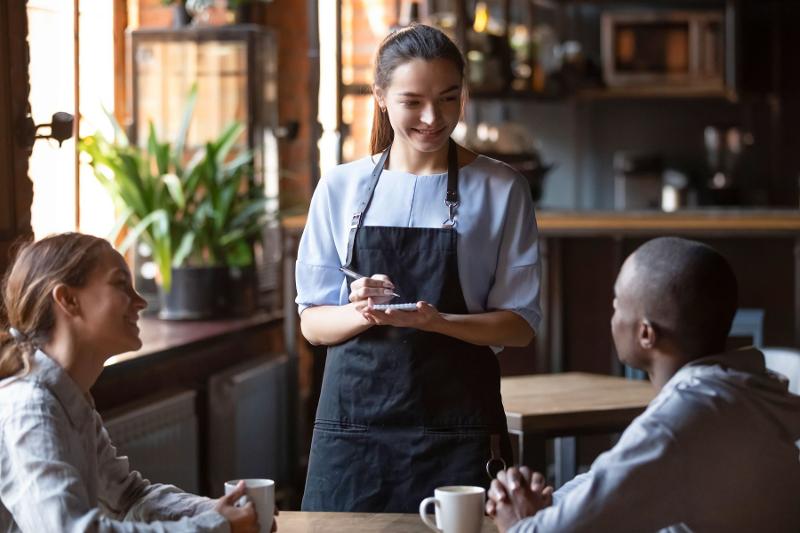Consumers spend more the longer they stay in a restaurant. / Photo: Shutterstock.
By Rich Shank
Source: www.restaurantbusinessonline.com, May 2023
Technomic’s Take: Diners, even if they’re alone, tend to spend more the longer they stay at a restaurant.
Imagine a middle-aged man (who wears a seasonal beard) stopping in for a quick pit-stop during the weekday lunch “hour.” There is a good chance he’s ordering to-go. However, there are days when the demands of work might push him into a booth out of the sight lines of passersby, some of whom may know him and probably think to themselves, “There he is. He’s stress eating again.” At least that is what I tell myself on those occasions. Hence the hidden booth.
On those two types of occasions, the sometimes-beardless diner is likely to make subtly different purchases even from the same restaurant (on different days, hopefully). On average, that lonely diner will order takeout and pay around $10. But on days where a little respite from the hustle and bustle of work is called for, he will decide to dine in, and his average spend will jump to $12. But if, however, the context enables that same often-beardless wonder to stay in the booth 15 minutes or more, then he’s likely to spend $15 on average. That is a 50% jump from take-out checks.
Now suppose, despite his current lack of beard, this man has friends, a family and coworkers who sometimes don’t mind sharing a meal with him. Sure, they may ask, “What happened to the beard? And he might say, “Well Chicago winters are cold. My face was in seasonal hibernation the last time we spoke.” But after that awkward “you’ve changed” moment, they will order food and drinks, then share some laughs, well except for if the kids are involved, their love language is expressed through a high volume of eyerolls and sighs. But those kids …oh those kids, just know your parents will be secretly returning the sigh-filled, eye-rolling favor when the check arrives at the table. Why? Because we remember the meal we just ate in that peaceful out-of-the-way booth. You know the one where we spent 100% less (on average) than what we are about to pay when our kids (17 and under) are with us. Perhaps we also remember, quite fondly, the rare date night where we spent approximately $10 less on a full-service meal than that meal we ate with our children as well. It’s hard to say.
You might be asking, “Why does this matter?” Or “Who really cares?” Of course, we pay more when there are more mouths to feed. “Perhaps, if you hadn’t shaved your beard, you would have recognized that before boring me with your anecdotes.” What is interesting about that is that our dining party often impacts the time we spend in a unit and the amount of money we spend while dining in. Even dining in at limited-service restaurants is heavily correlated with how much time we spend inside the restaurant—making time and money a perfect pairing in most restaurants.
If you take the time and money relationship seriously, then the idea of throttling down on our dine-in strategies to preserve on costs or to narrow our focus to off-premises occasions only is causing us to miss the occasions that drive check-average. Families with children have always been the biggest spenders on foodservice and that too is largely a function of time (i.e., limited time to cook due to commuting between work, home and children’s activities). But this relationship even holds for my “fictional” sometimes beardless diner who spends a little bit more the longer he mopes around in his out-of-way booth.
That “fictional” diner is more likely to get the drink and the side and to make a slightly more indulgent entrée choice during those respite moments where I/he just want(s) to sit down and relax for 15 minutes. When on the go, those menu choices are going to be different and result in a reduced amount of spend. It’s why some restaurants who are returning to pre-pandemic service hours are finding natural growth through extended hours. The occasions that were missed just happened to be some of the most valuable and they are just missed occasions, so additional trips are now available to the restaurant.
But this time and money pairing also speak to the importance of experience. Big experiences, drive big checks. Nights with friends, family celebrations, date nights, etc. will become more valuable the more engaged those diners are and for extended periods. Modest experiences, like my respite-inspired pitstop, drive modestly higher checks, but when the kids are involved—when that check arrives—it’s higher cost eyerolls all the way down and if I may make one more beard joke…well…sigh. I’ll just sit over here in eat in peace.
For more information on pricing and menu research, click here or reach out to Technomic at info@technomic.com or technomic.com. Technomic is a sister company of Restaurant Business.
Members help make our journalism possible. Become a Restaurant Business member today and unlock exclusive benefits, including unlimited access to all of our content. Sign up here.

